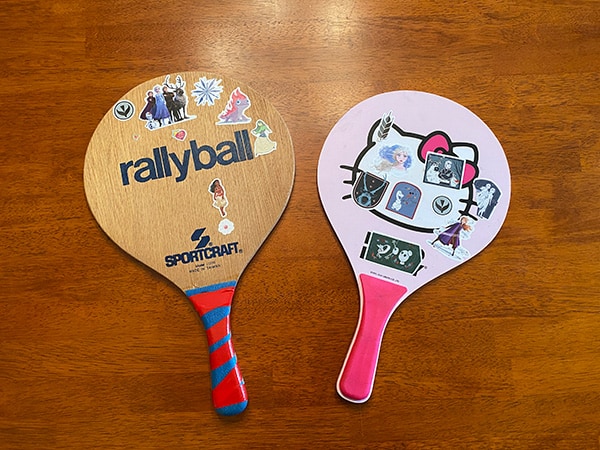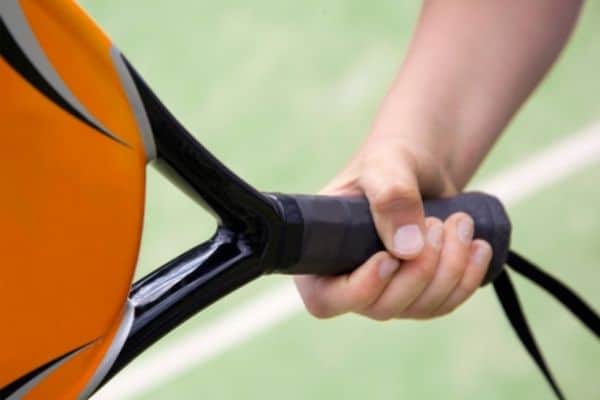
When you’re in the market for a pickleball paddle, it may get confusing how to choose a pickleball paddle. As a beginner, paddles may essentially look the same. Between shape, material, weight, and all the marketing, how can you filter the information to what you need? We will go over what to look for and how to choose a pickleball paddle.
How To Choose A Pickleball Paddle
Here are the criteria that will help you choose your pickleball paddle.
Weight
The most important factor to consider when you’re choosing a pickleball paddle is the weight. Pickleball paddles can be categorized into three weight classes. While the difference between the weight classes may not seem much, it makes a difference when you’re playing. If you have a weaker grip, arthritis, or tennis elbow, you may want to stay away from heavier paddles.
| Pickleball Paddle Weight Class | Weight in ounces | Example Paddles |
| Lightweight paddles | Under 7.3 | Evoke Tear Drop |
| Midweight paddles | 7.4 – 8.2 | Onix Z5 (Graphite) |
| Heavyweight paddles | 8.3 and above | Onix Z5 (Composite) |
On the other hand, you may find that lighter paddles will lack power. To make up for power, you will find that you have more control. To get a bit of both worlds, midweight paddles will be suitable for most people. The good news is, that there are more options for midweight paddles than lightweight or heavyweight paddles on the market.
Traditional or elongated paddle

Traditional pickleball paddles are your typical paddles that are about 8 inches in width and 16 inches in total height. Compared to an elongated paddle, you will be shorter and wider. A popular example of a traditional pickleball paddle is the ONIX Graphite Z5.
An elongated paddle is, therefore, narrower but longer. An example of an elongated paddle is the HEAD Radical XL paddle with a width of 7 inches and a length of 17 inches. Elongated paddles provide more reach for those with shorter arms. Or if you’re not able to move your body to react as quickly. However, it will require more accuracy in contacting the paddle face to the ball or hitting the “sweet spot” since the paddle face is an inch narrower.
Material of paddle face
Other than weight, the material of the paddle face makes the biggest difference when it comes to pickleball paddles. Pickleball paddles can be made of traditional wood, graphite, fiberglass, or composite. Wood is no longer a popular choice. Most people will choose between graphite, fiberglass, or a composite paddle face. So what is the difference?

Wood paddles are the cheapest and more carefree paddles. So if you want the least amount of money invested in your pickleball gear, wood paddles are a good option. If you have young kids wanting to play with you, wood paddles make sense since young children may not have the coordination to avoid scratching the paddle edges. You can find a set of 4 paddles and balls for less than $30.
Out of the remaining three materials, most beginners will not see much difference using a graphite paddle, a composite paddle, or a fiberglass paddle. If you’ve been playing pickleball regularly, you may notice a difference when you use a paddle with a graphite paddle face. It has a certain louder *pop* when you’re hitting the ball. Especially when a ball comes to you high, there is a power you can feel when you smash down and the paddle contacts the ball.
Fiberglass is advertised to be able to give you more spin on the ball. That is because they’re generally more textured. However, your technique is much more important when it comes to putting a spin on the ball.
Composite paddles are made of different materials. It can be a mix of graphite and other materials. Like fiberglass, composite paddles are advertised to be able to give you more spin. Again, spin comes with a textured surface on the paddle face. Neither composite, graphite, nor fiberglass is superior in performance. It will come down to the user’s preference.
What about the pickleball paddle core? You will often see paddles advertised with polypropylene core or certain trademarked cores like Nomax. The differences may not be noticeable to most players. What does make a difference is the thickness of the paddle face. A thicker face will absorb more of the force of the impact while a thinner face will give you more power.
Paddle handle

When you’re considering a paddle, keep in mind the handle length and width. Most pickleball paddle handles have a length of 4.75 inches to 5.6 inches. A longer handle length helps if you tend to use both hands when hitting with your backhand. A longer handle means you can also get more power since it is essentially an extension of your arms. But a longer handle also means that the paddle face will have to be shorter so it will affect the “sweet spot” when you hit.
Then there is the paddle handle width or the handle grip size. Of all criteria considered, the paddle handle width should be the least of your concerns when choosing a pickleball paddle. Especially if you feel that your paddle grip is too narrow. Why is that?
Because there is overwrap tape that will make the adjustment you need for your grip. In fact, you will want to use an overwrap for several reasons. The first is to protect your paddle grip with overwear. Secondly, an overwrap tape can add width to your grip so if your hands are bigger but your paddle handle is too small, you can solve the problem right away. Lastly, if you have sweaty palms or you happen to be playing in a humid state, a dry overgrip will give you a comfortable grip.
Price
For many people, price is perhaps the most important factor when it comes to choosing a pickleball paddle. The good news is that you can stay within your budget and still get a decent paddle. In fact, with all the criteria mentioned being the same, the difference in performance between an $80 paddle and a $150 paddle may not be noticeable enough to justify the price difference. So you can comfortably choose the cheapest paddle that fits the shape, weight, and grip that suits your preferences.
More Pickleball Tips
If choosing a pickleball paddle is still overwhelming, you can find pickleball paddle demo programs online. You can select several paddles and they will ship them out to you to try out. You will be able to use and test them for a specified time before committing to one.
There are also tennis shops and clubs that carry pickleball equipment where you can feel different paddles in your hands. Many pickleball instructors offer demo paddles if you join a clinic with them. If you’re regularly going to recreation places to play, you can also ask to test out other players’ paddles. Choosing a pickleball paddle is very subjective so test different ones until you find one you love.
Read Next: Best Pickleball Paddles Under $100
Read Also: 5 Pickleball Paddles That Are Actually Worth The Money

